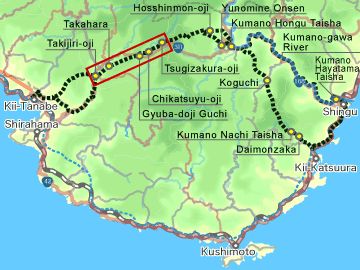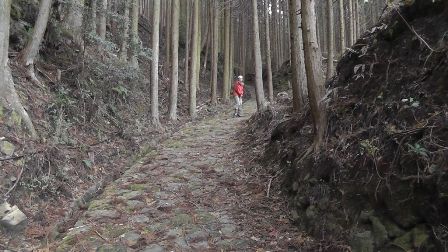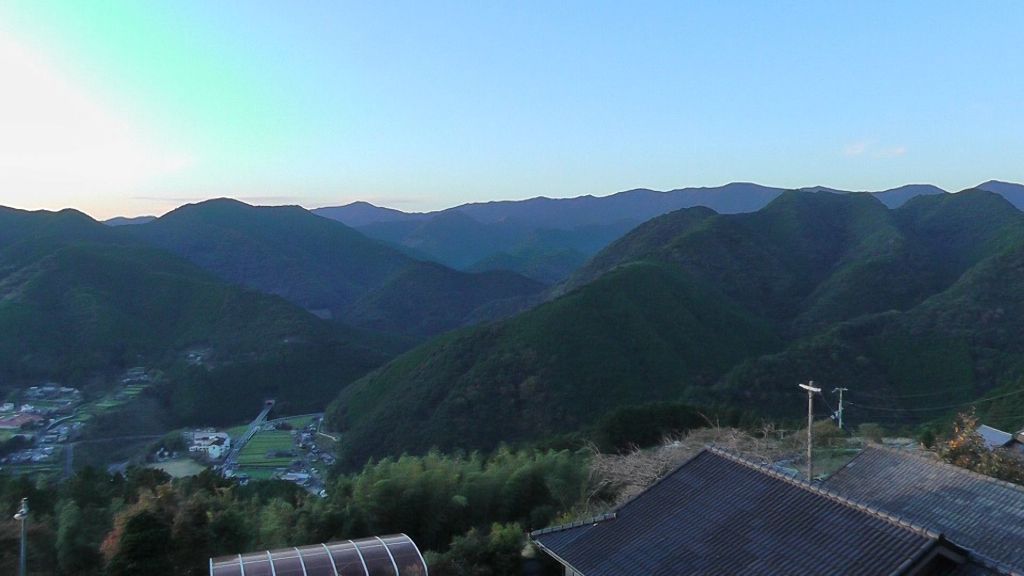July 8 - 14, 2012: Issue 66
The Kumano Kodo
Takijiri oji to Takahara, Takahara to Nonaka, bus to Hongu Taisha, Typhoon broken trail, Yunomine, Kyoto.
On the Kumano Kodo
On the beaten track
Huge Torii at Kumano Hongu Taisha; the largest Torii shrine gate in the world.
Our old friend the purifying dragon
Hongu Taisha building. Below: Door
High street Yunomine (younormineh)
Big little bell
A Hongu princess who very nearly got her peace sign right
Copyright Paul Wheeler and Kerry Ritson, 2012. All Rights Reserved.
Paul Wheeler Articles on Japan:
Takayama Yokahama and Yudanaka Toba and Kii Katsuura Nara and Kyomizu dera
The Kumano Kodo
by Paul Wheeler
 The Kumano Kodo, ‘ancient road of Kumano’, is a series of ancient pilgrimage routes that crisscross the Kii Hantō, the largest Peninsula of Japan and is the pilgrimage road that led to Kumano Sanzan (the three grand shrines of Kumano: Hongu-taisha, Hayatama-taisha, Nachi-taisha). Kumano is located south of Yoshino, honoured as a sacred place where the gods have lived since ancient times. The religion spread from the Imperial House to ordinary people, many pilgrims visiting Kumano. The spread of the religion is attributed to the gods of Kumano being generous and accepting anybody, without regards to status or gender. (1).
The Kumano Kodo, ‘ancient road of Kumano’, is a series of ancient pilgrimage routes that crisscross the Kii Hantō, the largest Peninsula of Japan and is the pilgrimage road that led to Kumano Sanzan (the three grand shrines of Kumano: Hongu-taisha, Hayatama-taisha, Nachi-taisha). Kumano is located south of Yoshino, honoured as a sacred place where the gods have lived since ancient times. The religion spread from the Imperial House to ordinary people, many pilgrims visiting Kumano. The spread of the religion is attributed to the gods of Kumano being generous and accepting anybody, without regards to status or gender. (1).
We caught the Super Koroshio #12 from Kii Katsuura to Kii Tanabe and we were met at the station by Ms.Noriko Furukubo and Ms.Yui Miyazaki from the Tanabe City Kumano Tourism Bureau. They gave us fruit and sandwiches and a run down on the state of the Trail to Kumano Hongu Taisha. Actually I think they were also having a look at two old goats to see if they thought we'd make it. Most of the repairs from the typhoon had been completed but we weren't going to be able to do the last days walk as we had intended.
Actually this wasn't a tragedy as we would have had two days walking on the mountain trails and we would able to spend a more leisurely time at the temple in Hongu Taisha. In my capacity as a degenerate bass guitarist with the odd band or two I was used to being met at the airport and bunged in the Tarago to go where ever, but in my capacity as a tourist this had not happened before and we were very grateful for the assistance and the orientation talk before we left on the correct bus, as indicated by the very helpful young ladies.

Up out of Takahara
We got off the bus at Takijiri Oji, the start of the trail for us, and there was the little truck from the Takahara Kiri-No Sato waiting for our luggage outside the Kumano Kodo Kan Pilgrimage centre. As we gained altitude on the trail, which happened quickly, the road noise faded and we entered the quiet of the cedar forest. It was hard but the track was good and well marked and all in all walking the Kumano Kodo was something I won’t forget.
Having a little rest on the way to Nonaka
I'm neither Shinto nor Buddhist and so the significance of some of the things we saw passed me by but just being on the trail was a very peaceful if somewhat strenuous experience. The path is dotted with small shrines and at some of them you can leave a small donation and put a stamp on a piece of paper, I'm not sure why I was doing it but it seemed like a good idea.
On we went and eventually came to a road which led to the Ryokan Kiri No Sato at Takahara. Well actually I went the wrong way; put it down to travelling all day, a hard climb, an inability to look at the right bit of the map, and an extraordinary manner of not seeing a bloody great sign on the other side of the road pointing to the track in ENGLISH. The day was saved by a nice lady with a mobile phone who didn't abandon us and the staff sending out a truck to pick the clot up.
Ryokan Kiri No Sato
The Ryokan was wonderful... modern architecture, an deliciously edgy take on Ryokan food, lovely rooms and baths, cool jazz playing softly, a view to die for from every room, very, very nice people and cold beer. I would have liked to have gone back after our next days walking actually, it was so good.
From our room at the ryokan
When you do your research on the sacred trail you can find maps with the elevations clearly marked on them. As a rule of thumb the first climb of the day, you always start with a climb, is like the smugglers track up to Barrenjoey lighthouse except it goes on for a lot longer. Once you've achieved the ridge though it all gets a lot easier and generally you end up with a gentle descent to your destination.
Very quiet in the Cedars
Because we did the Track in late autumn we didn't see anyone all day on the way from Takahara to Nonaka, where we stayed the second night, until we passed through Chikatsuyu where there were lots of people walking around the historic sites of that town. We did see some interesting small oji though and some small shrines like that of the abdicated emperor Kazan who was one of the first to make the pilgrimage. Apparently he made it seated on a cow and a horse.
Gubya Doji, The Abdicated Emporer Kazan riding his horse and cow on an early pilgrimage
Kerry took quite a few photographs of his statue and was quite frustrated because every one looked as though the statue was made of Jade when in real life it was just a light coloured stone. I think he was having a giggle myself.
There was also a sign board dedicated to a Yamabushi mountain ascetic who told the people of Chikatsuyu that if they came to look at the next full moon on November the 23rd at Mt Takao with him they would see three moons. It actually was Nov 23rd when we walked past the sign, 2011 though, and I'm sorry to say that I was too buggered to notice whether there was a full moon that night as I was almost certainly snoring at the time.
The next morning, because the trail was broken, we caught a bus from Nonaka to Hongu Taisha. The girls in Tanabe suggested we view the shrine and then go further by bus in the opposite direction to the way we would have walked until we reached the break in the trail and then turn around and walk back. We didn't, the shrine was beautiful and worth much more time than a cursory look, the town was very nice and we decided instead to walk to Yunomine where we had accommodation for the night.
The symbol of Hongu Taisha; Yata-garasu Crow or three foot crow
From Hongu to Yunomine is not far as the crow flies but the Path was the steepest and the longest climb we did. It was also lovely. There is a UNESCO listed onsen at yunomine which we wanted to bathe in and as we walked into town we could see it was being used but by the time we had checked in and had a little wander it was available for hire. Very hot indeed ... but you just keep cold water going in and you don’t get cooked. The hot water comes up through the rocks at the base of a little well by the river with a very rustic shed over the top of it all.
Inside the Unesco listed Onsen, very old , very hot, very good for what ails you
Yunomine is really just a one street town but very pretty with constant clouds of steam from the geysers all around and we had a very restful night at the Ryokan Adumaya with more baths and a very nice meal a lot of which was cooked in the local volcanic water.
The next morning it was onto the free community bus back to Hongu where we caught the public bus back to Tanabe to get on the train for our last stop in Japan, Kyoto.

The Kumano Kodo
Kumano Kodo Kan at Takajiri oji

The view from Kiri no Sato

Stairway to heaven
A tiny little pond on the way into Chikatsuyu
Emporer Kazan riding his horse and cow on an early pilgrimage
This photo was taken on the 23rd of November funnily enough

UNESCO listed onsen

The trail to Yunomine